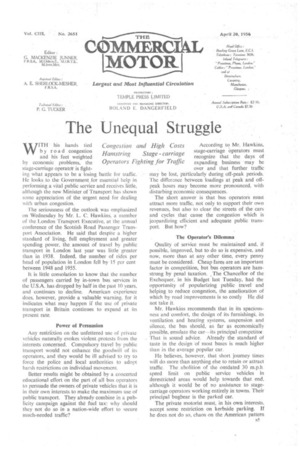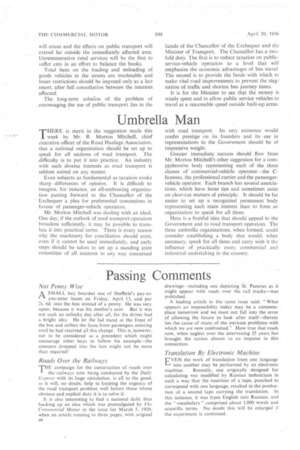The Unequal Struggle
Page 39

Page 40

If you've noticed an error in this article please click here to report it so we can fix it.
Congestion and High Costs Hamstring Stage carriage Operators Fighting for Traffic
virfl his hands tied by road congestion and his feet weighted by economic problems, the stage-carriage operack is fighting what appears to be a losing battle for traffic. He looks to the Government, for essential help in performing a vital public service and receives little, although the new Minister of Transport has shown some appreciation of the urgent need for dealing with urban congestion.
The seriousness of the outlook was emphasized on Wednesday by Mr. L. C. Hawkins, a member of the London Transport Executive, at the annual conference of the Scottish Road Passenger Transport Association. He said that despite a higher standard of living, full employment and greater spending power, the amount of travel by public transport in London last year was little greater than in 1938. Indeed, the number of rides per head of population in London fell by 15 per cent between 1948 and 1955.
It is little consolation to know that the number of passengers carried by in-town bus services in the U.S.A. has dropped by half in the past 10 years, and continues to decline. American experience does, however, provide a valuable warning, for it indicates what may happen if the use of private transport in Britain continues to expand at its present rate.
Power of Persuasion Any restriction on the unfettered use of private vehicles naturally evokes violent_protests from the interests concerned. Compulsory travel by public transport would not enhance the goodwill of its operators, and they would be ill advised to try to force the police and local authorities to adopt harsh restrictions on individual movement.
Better results might be obtained by a concerted educational effort on the part of all bus operators to persuade the owners of private vehicles that it is in their own interests to make the maximum use of public transport. They already combine in a publicity campaign against the fuel tax: why should they not do so in a nation-wide effort to secure much-needed traffic? According to Mr. Hawkins, stage-carriage operators must recognize that the days of expanding business may be over and that further traffic may be lost, particularly during off-peak periods. The difference between loadings at peak and offpeak hours may become more pronounced, with disturbing economic consequences.
The short answer is that bus operators must attract more traffic, not only to support their own revenues, but also to clear the streets of the cars and cycles that cause the congestion which is jeopardizing efficient and adequate public transport. But how?
The Operator's Dilemma Quality of service must be maintained and, it possible, improved, but to do so is expensive, and now, more than at any other time, every penny must be considered. Cheap fares are an important factor in competition, but bus operators are hamstrung by penal taxation. ..The Chancellor of the Exchequer, in his Budget last Tuesday, had the opportunity of popularizing public travel and helping to reduce congestion, the amelioration of which by road improvements is so costly He did not take it.
Mr. Hawkins recommends that in its spaciousness and comfort, the design of its furnishing,, its ventilation and heating systems, suspension and silence, the bus should, as far as economically possible, emulate the car--its principal competitar. That is sound advice. Already the standard of taste in the design 'of most buses is much higher than in the average popular car.
He believes, however, that short journey times will do more than anything else to retain or attract traffic. The abolition of the outdated 30 m.p.h speed limit on public service vehicles in derestricted areas would help towards that end, although it would be of no assistance to stagecarriage operators working entirely in towns. Their principal bugbear is the parked car.
The private motorist must, in his own, interests, accept some restriction on kerbside parking. If he does not do so, chaos on the American pattern will ensue and the effects on public transport will extend far outside the immediately affected area. Unremunerative rural services will be the first to suffer cuts in an effort to balance the books.
Total bans on the loading and unloading of goods vehicles in the streets are intolerable and lesser restrictions should be imposed only as a last resort, after full consultation between the interests affected.
The long-term solution of the problem of encouraging the use of public transport lies in the hands of the Chancellor of the Exchequer and the Minister of Transport. The Chancellor has a twofold duty. The first is to reduce taxation on public• service-vehicle operation to a level that will emphasize the economic advantages of bus travel The second is to provide the funds with which to make vital road improvements to prevent the stag= nation of traffic and shorten bus journey times.
It is for the Minister to see that the money is wisely spent and to allow public service vehicles to travel at a reasonable speed outside built-up areas




















































































































